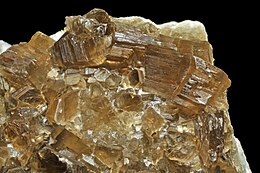| Phlogopite | |
|---|---|
 | |
| General | |
| Category | Mica, phyllosilicates |
| Formula (repeating unit) | KMg3(AlSi3O10)(F,OH)2 |
| IMA symbol | Phl[1] |
| Strunz classification | 9.EC.20 |
| Crystal system | Monoclinic |
| Crystal class | Prismatic (2/m) (same H-M symbol) |
| Space group | C2/m |
| Identification | |
| Color | Brown, brownish red, dark brown, yellow, yellowish brown, green, white and gray |
| Crystal habit | Tabular, scaly masses, rarely perfect phenocryst tablets |
| Twinning | Composition twinning |
| Cleavage | Perfect basal (001) |
| Fracture | None |
| Tenacity | Tough, flexible thin laminae |
| Mohs scale hardness | 2–2.5 |
| Luster | Pearly, sometimes slightly metallic on cleavage surfaces |
| Streak | White |
| Diaphaneity | Transparent to translucent |
| Specific gravity | 2.78–2.85 |
| Optical properties | Biaxial (−), 2V=12 |
| Refractive index | nα = 1.530–1.573 nβ = 1.557–1.617 nγ = 1.558–1.618 |
| Birefringence | δ =0.0280–0.0450 |
| 2V angle | 16–20° |
| Other characteristics | Fluorescent |
| References | [2][3][4][5] |
Phlogopite is a yellow, greenish, or reddish-brown member of the mica family of phyllosilicates. It is also known as magnesium mica.
Phlogopite is the magnesium endmember of the biotite solid solution series, with the chemical formula KMg3AlSi3O10(F,OH)2. Iron substitutes for magnesium in variable amounts leading to the more common biotite with higher iron content. For physical and optical identification, it has most of the characteristic properties of biotite.
- ^ Warr, L.N. (2021). "IMA–CNMNC approved mineral symbols". Mineralogical Magazine. 85 (3): 291–320. Bibcode:2021MinM...85..291W. doi:10.1180/mgm.2021.43. S2CID 235729616.
- ^ Mineralienatlas
- ^ Phlogopite WebMineral
- ^ http://rruff.geo.arizona.edu/doclib/hom/phlogopite.pdf Handbook of Mineralogy
- ^ http://www.mindat.org/min-3193.html Mindat